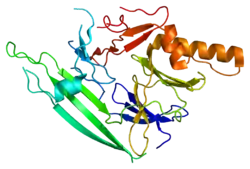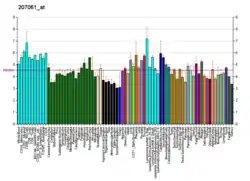ERN1
The serine/threonine-protein kinase/endoribonuclease inositol-requiring enzyme 1 α (IRE1α) is an enzyme that in humans is encoded by the ERN1 gene.[4][5]
Function
The protein encoded by this gene is the ER to nucleus signalling 1 protein, a human homologue of the yeast Ire1 gene product. This protein possesses intrinsic kinase activity and an endoribonuclease activity and it is important in altering gene expression as a response to endoplasmic reticulum-based stress signals (mainly the unfolded protein response). Two alternatively spliced transcript variants encoding different isoforms have been found for this gene.[5]
Signaling
IRE1α possesses two functional enzymatic domains, an endonuclease and a trans-autophosphorylation kinase domain. Upon activation, IRE1α oligomerizes and carries out an unconventional RNA splicing activity, removing an intron from the X-box binding protein 1 (XBP1) mRNA, and allowing it to become translated into a functional transcription factor, XBP1s.[6] XBP1s upregulates ER chaperones and endoplasmic reticulum associated degradation (ERAD) genes that facilitate recovery from ER stress.
Interactions
ERN1 has been shown to interact with Heat shock protein 90kDa alpha (cytosolic), member A1.[7]
Inhibitors
Two types of inhibitors exist targeting either the catalytic core of the RNase domain or the ATP-binding pocket of the kinase domain.
References
- GRCh38: Ensembl release 89: ENSG00000178607 - Ensembl, May 2017
- "Human PubMed Reference:". National Center for Biotechnology Information, U.S. National Library of Medicine.
- "Mouse PubMed Reference:". National Center for Biotechnology Information, U.S. National Library of Medicine.
- Tirasophon W, Welihinda AA, Kaufman RJ (Jul 1998). "A stress response pathway from the endoplasmic reticulum to the nucleus requires a novel bifunctional protein kinase/endoribonuclease (Ire1p) in mammalian cells". Genes Dev. 12 (12): 1812–24. doi:10.1101/gad.12.12.1812. PMC 316900. PMID 9637683.
- "Entrez Gene: ERN1 endoplasmic reticulum to nucleus signalling 1".
- Calfon M, Zeng H, Urano F, Till JH, Hubbard SR, Harding HP, Clark SG, Ron D (January 2002). "IRE1 couples endoplasmic reticulum load to secretory capacity by processing the XBP-1 mRNA". Nature. 415 (6867): 92–6. doi:10.1038/415092a. PMID 11780124. S2CID 4319118.
- Marcu MG, Doyle M, Bertolotti A, Ron D, Hendershot L, Neckers L (December 2002). "Heat shock protein 90 modulates the unfolded protein response by stabilizing IRE1alpha". Mol. Cell. Biol. 22 (24): 8506–13. doi:10.1128/MCB.22.24.8506-8513.2002. PMC 139892. PMID 12446770.
- Volkmann K, Lucas JL, Vuga D, Wang X, Brumm D, Stiles C, Kriebel D, Der-Sarkissian A, Krishnan K, Schweitzer C, Liu Z, Malyankar UM, Chiovitti D, Canny M, Durocher D, Sicheri F, Patterson JB (April 2011). "Potent and selective inhibitors of the inositol-requiring enzyme 1 endoribonuclease". J. Biol. Chem. 286 (14): 12743–55. doi:10.1074/jbc.M110.199737. PMC 3069474. PMID 21303903.
- Cross BC, Bond PJ, Sadowski PG, Jha BK, Zak J, Goodman JM, Silverman RH, Neubert TA, Baxendale IR, Ron D, Harding HP (April 2012). "The molecular basis for selective inhibition of unconventional mRNA splicing by an IRE1-binding small molecule". Proc. Natl. Acad. Sci. U.S.A. 109 (15): E869–78. doi:10.1073/pnas.1115623109. PMC 3326519. PMID 22315414.
- Mimura N, Fulciniti M, Gorgun G, Tai YT, Cirstea D, Santo L, Hu Y, Fabre C, Minami J, Ohguchi H, Kiziltepe T, Ikeda H, Kawano Y, French M, Blumenthal M, Tam V, Kertesz NL, Malyankar UM, Hokenson M, Pham T, Zeng Q, Patterson JB, Richardson PG, Munshi NC, Anderson KC (June 2012). "Blockade of XBP1 splicing by inhibition of IRE1α is a promising therapeutic option in multiple myeloma". Blood. 119 (24): 5772–81. doi:10.1182/blood-2011-07-366633. PMC 3382937. PMID 22538852.
- Papandreou I, Denko NC, Olson M, Van Melckebeke H, Lust S, Tam A, Solow-Cordero DE, Bouley DM, Offner F, Niwa M, Koong AC (January 2011). "Identification of an Ire1alpha endonuclease specific inhibitor with cytotoxic activity against human multiple myeloma". Blood. 117 (4): 1311–4. doi:10.1182/blood-2010-08-303099. PMC 3056474. PMID 21081713.
- Ri M, Tashiro E, Oikawa D, Shinjo S, Tokuda M, Yokouchi Y, Narita T, Masaki A, Ito A, Ding J, Kusumoto S, Ishida T, Komatsu H, Shiotsu Y, Ueda R, Iwawaki T, Imoto M, Iida S (July 2012). "Identification of Toyocamycin, an agent cytotoxic for multiple myeloma cells, as a potent inhibitor of ER stress-induced XBP1 mRNA splicing". Blood Cancer J. 2 (7): e79. doi:10.1038/bcj.2012.26. PMC 3408640. PMID 22852048.
- Wang L, Perera BG, Hari SB, Bhhatarai B, Backes BJ, Seeliger MA, Schürer SC, Oakes SA, Papa FR, Maly DJ (December 2012). "Divergent allosteric control of the IRE1α endoribonuclease using kinase inhibitors". Nat. Chem. Biol. 8 (12): 982–9. doi:10.1038/nchembio.1094. PMC 3508346. PMID 23086298.
Further reading
- Katayama T, Imaizumi K, Sato N, et al. (2000). "Presenilin-1 mutations downregulate the signalling pathway of the unfolded-protein response". Nat. Cell Biol. 1 (8): 479–85. doi:10.1038/70265. PMID 10587643. S2CID 30259483.
- Urano F, Wang X, Bertolotti A, et al. (2000). "Coupling of stress in the ER to activation of JNK protein kinases by transmembrane protein kinase IRE1". Science. 287 (5453): 664–6. doi:10.1126/science.287.5453.664. PMID 10650002. S2CID 9154084.
- Dias Neto E, Correa RG, Verjovski-Almeida S, et al. (2000). "Shotgun sequencing of the human transcriptome with ORF expressed sequence tags". Proc. Natl. Acad. Sci. U.S.A. 97 (7): 3491–6. doi:10.1073/pnas.97.7.3491. PMC 16267. PMID 10737800.
- Iwawaki T, Hosoda A, Okuda T, et al. (2001). "Translational control by the ER transmembrane kinase/ribonuclease IRE1 under ER stress". Nat. Cell Biol. 3 (2): 158–64. doi:10.1038/35055065. PMID 11175748. S2CID 7756732.
- Yoneda T, Imaizumi K, Oono K, et al. (2001). "Activation of caspase-12, an endoplastic reticulum (ER) resident caspase, through tumor necrosis factor receptor-associated factor 2-dependent mechanism in response to the ER stress". J. Biol. Chem. 276 (17): 13935–40. doi:10.1074/jbc.M010677200. PMID 11278723.
- Lee K, Tirasophon W, Shen X, et al. (2002). "IRE1-mediated unconventional mRNA splicing and S2P-mediated ATF6 cleavage merge to regulate XBP1 in signaling the unfolded protein response". Genes Dev. 16 (4): 452–66. doi:10.1101/gad.964702. PMC 155339. PMID 11850408.
- Liu CY, Wong HN, Schauerte JA, Kaufman RJ (2002). "The protein kinase/endoribonuclease IRE1alpha that signals the unfolded protein response has a luminal N-terminal ligand-independent dimerization domain". J. Biol. Chem. 277 (21): 18346–56. doi:10.1074/jbc.M112454200. PMID 11897784.
- Nishitoh H, Matsuzawa A, Tobiume K, et al. (2002). "ASK1 is essential for endoplasmic reticulum stress-induced neuronal cell death triggered by expanded polyglutamine repeats". Genes Dev. 16 (11): 1345–55. doi:10.1101/gad.992302. PMC 186318. PMID 12050113.
- Marcu MG, Doyle M, Bertolotti A, et al. (2003). "Heat Shock Protein 90 Modulates the Unfolded Protein Response by Stabilizing IRE1α". Mol. Cell. Biol. 22 (24): 8506–13. doi:10.1128/MCB.22.24.8506-8513.2002. PMC 139892. PMID 12446770.
- Strausberg RL, Feingold EA, Grouse LH, et al. (2003). "Generation and initial analysis of more than 15,000 full-length human and mouse cDNA sequences". Proc. Natl. Acad. Sci. U.S.A. 99 (26): 16899–903. doi:10.1073/pnas.242603899. PMC 139241. PMID 12477932.
- Liu CY, Xu Z, Kaufman RJ (2003). "Structure and intermolecular interactions of the luminal dimerization domain of human IRE1alpha". J. Biol. Chem. 278 (20): 17680–7. doi:10.1074/jbc.M300418200. PMID 12637535.
- Kaneko M, Niinuma Y, Nomura Y (2004). "Activation signal of nuclear factor-kappa B in response to endoplasmic reticulum stress is transduced via IRE1 and tumor necrosis factor receptor-associated factor 2". Biol. Pharm. Bull. 26 (7): 931–5. doi:10.1248/bpb.26.931. PMID 12843613.
- Ota T, Suzuki Y, Nishikawa T, et al. (2004). "Complete sequencing and characterization of 21,243 full-length human cDNAs". Nat. Genet. 36 (1): 40–5. doi:10.1038/ng1285. PMID 14702039.
- Shang J, Lehrman MA (2004). "Discordance of UPR signaling by ATF6 and Ire1p-XBP1 with levels of target transcripts". Biochem. Biophys. Res. Commun. 317 (2): 390–6. doi:10.1016/j.bbrc.2004.03.058. PMID 15063770.
- Oono K, Yoneda T, Manabe T, et al. (2004). "JAB1 participates in unfolded protein responses by association and dissociation with IRE1". Neurochem. Int. 45 (5): 765–72. doi:10.1016/j.neuint.2004.01.003. PMID 15234121. S2CID 11627892.
- Huang ZM, Tan T, Yoshida H, et al. (2005). "Activation of Hepatitis B Virus S Promoter by a Cell Type-Restricted IRE1-Dependent Pathway Induced by Endoplasmic Reticulum Stress". Mol. Cell. Biol. 25 (17): 7522–33. doi:10.1128/MCB.25.17.7522-7533.2005. PMC 1190304. PMID 16107700.
- Kimura K, Wakamatsu A, Suzuki Y, et al. (2006). "Diversification of transcriptional modulation: Large-scale identification and characterization of putative alternative promoters of human genes". Genome Res. 16 (1): 55–65. doi:10.1101/gr.4039406. PMC 1356129. PMID 16344560.
- Hetz C, Bernasconi P, Fisher J, et al. (2006). "Proapoptotic BAX and BAK modulate the unfolded protein response by a direct interaction with IRE1alpha". Science. 312 (5773): 572–6. doi:10.1126/science.1123480. PMID 16645094. S2CID 9135901.
- Oikawa D, Tokuda M, Iwawaki T (2007). "Site-specific cleavage of CD59 mRNA by endoplasmic reticulum-localized ribonuclease, IRE1". Biochem. Biophys. Res. Commun. 360 (1): 122–7. doi:10.1016/j.bbrc.2007.06.020. PMID 17585877.




